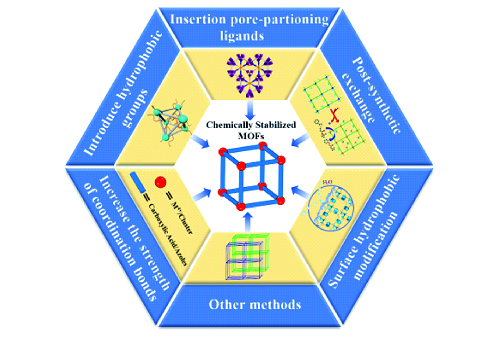 PDF(23677 KB)
PDF(23677 KB)


 PDF(23677 KB)
PDF(23677 KB)
 PDF(23677 KB)
PDF(23677 KB)
化学稳定金属有机框架的合成策略
Synthetic Strategies of Chemically Stable Metal-Organic Frameworks
金属有机框架(Metal-Organic Frameworks)是由金属离子或簇与有机配体通过配位键形成的具有孔洞结构的新一代晶态多孔材料,是近20年来配位化学领域的研究热点。作为新型多功能材料,MOFs具有高孔隙率、低密度、大比表面积、孔径可调、拓扑结构多样和可裁剪等优点,广泛应用于各种领域。尽管MOFs有许多优点,但是大多数MOFs材料的水和化学稳定性相对较差,在恶劣条件下结构无法保持,极大限制了它们的实际应用。因此,化学稳定的MOFs材料具有更大的应用前景。近年来,研究人员在提高MOFs化学稳定性方面进行了大量的探索,发展了一些非常好的方法合成化学稳定的MOFs材料。本文主要综述了近五年来化学稳定MOFs材料合成的最新研究进展。
Metal-organic frameworks (MOFs) are a new generation of crystalline porous materials with void space structures constructed from metal ions or clusters and organic ligands through coordination bonds, and have been a hot research topic in the field of coordination chemistry over the past two decades. As the novel multifunctional materials, MOFs have been widely used in various fields due to their high porosities, low densities, large surface areas, tunable pore sizes, diverse topological structures and tailorabilities. Although MOFs have many advantages, most of MOFs materials have relatively lower water and chemical stability and cannot maintain their structures under harsh conditions, which greatly restrict their practical applications under moisture-rich conditions. Therefore, chemically stable MOFs materials will have greater application prospects. In recent years, researchers have carried out a lot of exploration in improving the chemical stability of MOFs, and developed some excellent methods to synthesize chemically stable MOFs. This review will mainly focus on the latest research progress in the syntheses of chemically stable MOFs during the past five years.
1 Introduction
2 Synthetic strategies of chemically stable MOFs
2.1 Increase the strength of coordination bonds
2.2 Attaching hydrophobic groups onto the linker
2.3 Using pore-partioning ligands for the pore space partition
2.4 Post-synthetic exchange method
2.5 Hydrophobic surface treatment
2.6 Other methods
3 Conclusion and Outlook

metal-organic frameworks(MOFs) / chemical stability / synthetic strategy
| [1] |
|
| [2] |
|
| [3] |
(朱敦如, 周俊, 杨捷, 包魏魏, 沈旋. 南京工业大学学报(自然科学版), 2007, 29(3): 103.).
|
| [4] |
|
| [5] |
|
| [6] |
(封啸, 任颜卫, 江焕峰. 化学进展, 2020, 32(11): 1697.).
|
| [7] |
|
| [8] |
(赖欣宜, 王志勇, 郑永太, 陈永明. 化学进展, 2019, 31(6): 783.).
|
| [9] |
|
| [10] |
|
| [11] |
|
| [12] |
|
| [13] |
|
| [14] |
|
| [15] |
|
| [16] |
|
| [17] |
|
| [18] |
|
| [19] |
|
| [20] |
|
| [21] |
|
| [22] |
|
| [23] |
|
| [24] |
|
| [25] |
|
| [26] |
|
| [27] |
|
| [28] |
|
| [29] |
|
| [30] |
|
| [31] |
|
| [32] |
|
| [33] |
|
| [34] |
|
| [35] |
|
| [36] |
(张晋维, 李平, 张馨凝, 马小杰, 王博. 化学学报, 2020, 78: 597.).
|
| [37] |
|
| [38] |
|
| [39] |
|
| [40] |
|
| [41] |
|
| [42] |
|
| [43] |
|
| [44] |
|
| [45] |
|
| [46] |
|
| [47] |
|
| [48] |
|
| [49] |
|
| [50] |
|
| [51] |
|
| [52] |
|
| [53] |
|
| [54] |
|
| [55] |
|
| [56] |
|
| [57] |
|
| [58] |
|
| [59] |
|
| [60] |
|
| [61] |
|
| [62] |
|
| [63] |
|
| [64] |
|
| [65] |
|
| [66] |
|
| [67] |
|
| [68] |
|
| [69] |
|
| [70] |
|
| [71] |
|
| [72] |
|
| [73] |
|
| [74] |
|
| [75] |
|
| [76] |
|
/
| 〈 |
|
〉 |